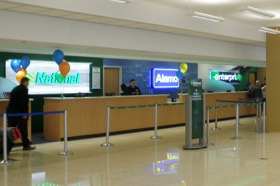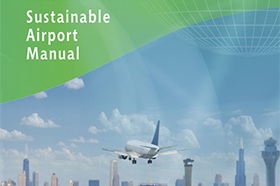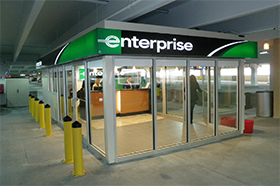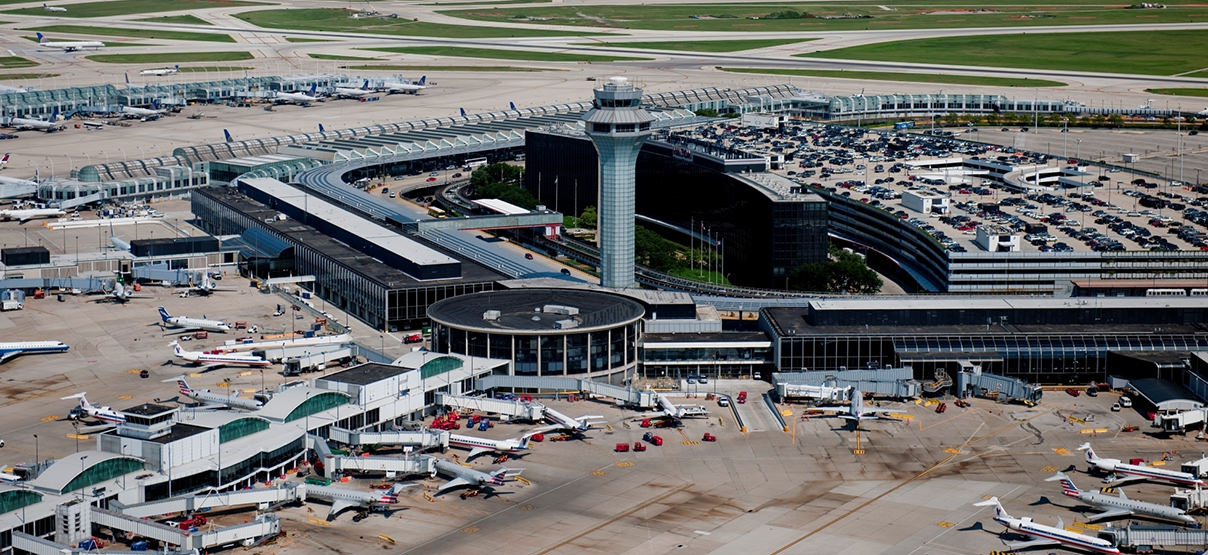
Whether you call it sustainable stormwater management, low-impact development, or green infrastructure, engineers are seeing it being implemented more and more throughout the country. Stormwater management practices, such as well-landscaped ponds that mimic natural wetlands or permeable pavement can be used most anywhere, but what if these practices are applied to unconventional locations such as airports? Now imagine the use of these techniques being wedged between two active runways in the commercial face of an airport (versus the public passenger-facing side) – this is what Chicago O’Hare Airport’s South Cargo Area looks like. As part of the Master Civil Engineer group for the O’Hare Modernization Program (OMP), Primera Engineers has served as the key reviewer for the Chicago Department of Aviation’s (CDA) sustainability requirements for all airport projects, including those in this stormwater management case study.
Stormwater management is a major concern at O’Hare, as it is for any airport. The vast areas of impermeable pavement and roof surfaces – over 2,300 acres total in O’Hare’s case – create huge volumes of stormwater runoff that lead to storm sewer systems on the airfield. This runoff is ultimately discharged to the Metropolitan Water Reclamation District (MWRD) for treatment because, for most of the year, the runoff is contaminated by aircraft deicing fluid and cannot be discharged to local receiving streams. Since the stormwater is sent to MWRD for treatment, the CDA must pay millions of dollars in fees to treat this stormwater annually.
When considering green stormwater techniques in any project, one must first consider the environment for which they will be set. Since an airport setting is so unique, engineers had to address some of these technologies with a little more scrutiny. For example, infiltration systems are usually encouraged, especially in the case of permeable pavement, but in an airport they would not make sense where the runoff is contaminated with deicing fluid that must be sent for treatment. As a result, permeable pavement only makes sense in non-aircraft movement areas. Another example is the use of native vegetation to promote infiltration or for green roof applications. At an airport, however, this can be problematic because certain native vegetation attracts wildlife which creates safety issues for aircraft. Due to this concern, the OMP developed a special landscaping specification which includes species of plants that are acceptable and those which are explicitly banned. With the approval of the United States Department of Agriculture (USDA), specific plants were chosen to minimize wildlife attraction, which were also low-maintenance and drought tolerant. Although there was initial skepticism on the use of green stormwater techniques at an airport, Primera, with the help of the various airport stakeholders, was able to find ways to address many of the concerns.
The study area that we are focusing on for the purpose of this article is a 120-acre area on the western end of the South Cargo Area that is shown in the picture below:

This area was chosen because almost the entire site has been built since the OMP was initiated (the eastern side of the South Cargo Area predates the OMP). The focus area includes several major building projects including the FedEx Cargo Facility, FedEx World Services Center, FedEx Vehicle Maintenance Building, United Airlines (UAL) Cargo Building, and the FAA South Air Traffic Control Tower. These projects, including the two new runways, have complied with the CDA’s Sustainable Airport Manual’s (SAM) requirements.
More than 75% of this area is impervious, consisting mainly of pavement. However, five green roofs and three permeable pavement parking lots contribute to the quantity control and treatment of the stormwater runoff in this area. The key statistics of these features are shown in the figure below. The main highlights include the 4.0-acre green roof on the FedEx Cargo Facility and the 2.6-acre permeable paver parking lot at the United Airlines Cargo Building employee parking lot – some of the largest examples of each in the Chicago area. In addition, some of the parking lot and roof runoff from the UAL facility has been diverted to the Bensenville Ditch rather than being discharged to the MWRD.
It should be noted that vegetated green roofs, especially ones where the soil profile exceeds 4 inches, are especially effective in Chicago at limiting runoff because of the local rainfall characteristics. Research shows that vegetated green roofs evapotranspirate and absorb anywhere from ½ to 1 inch of initial rainfall. Chicago National Weather Service Office records dating from 1871 to 2007 indicate that 90% of all precipitation events in Chicago are less than ½ inch and more than 95% are 1 inch or less meaning that 90%-95% of precipitation falling on a green roof never reaches the ground.
For our 120-acre focus area the average annual volume of stormwater that falls on the site is 117 million gallons. Of this volume, 8.8 million gallons is diverted from the combined sewer system due to infiltration at the permeable parking lots or absorbed by the green roofs. Granted this represents only about 8% of the total rainfall volume, but the 120-acre focus area only accounts for less than 4% of the total airport impervious area. If this sort of treatment could be applied uniformly across the airport (a lofty goal to be sure!), the volume of water that would be diverted on an annual basis would be over 220 million gallons, a significant amount in terms of volume and treatment costs. Although not feasible uniformly across the entire airport, this small focus area highlights the possibilities of what can be done.






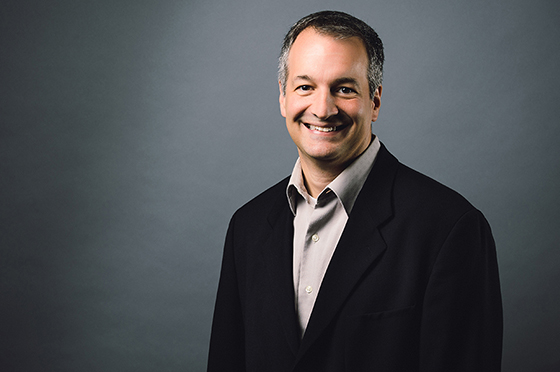
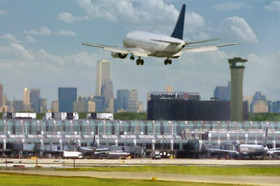
 O’Hare Airport Concessions Take Off
O’Hare Airport Concessions Take Off 
